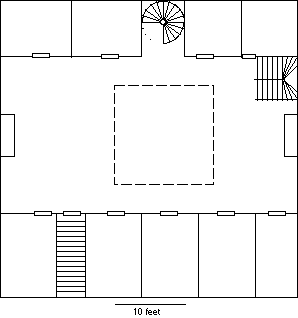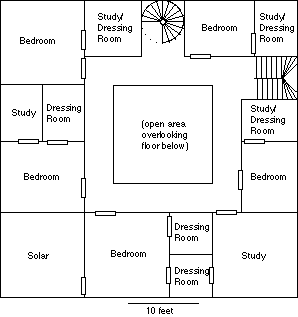Main Keep

Ground Floor
The ground floor contains the kitchen, which has a sizable fireplace against
the west wall, a strongroom against the north wall (which shares a face
with the curtain wall), and a number of other rooms which might be used
for storage or servants quarters, although the connecting rooms to the strongrooms
are more likely to be used as quarters for trusted fighting men or just
storage rather than quarters for lesser servants. The ground floor has one
exit, at the east side. The grey area near the southeast corner is "dead
space," not available for storage or living quarters. The space is
occupied by the stairs leading to the second floor. The ground floor communicates
with the upper stories by the spiral staircase at the middle of the north
side. Every room with an exterior wall, except the strongroom, has an arrow
slit every ten to fifteen feet.

Second Floor
The second floor is taken up mostly by the grand hall, a large open room
suitable for banquets, court proceedings, and, in a pinch, sleeping space
for soldiers. The hall is also heated by large fireplaces at the east and
west ends. The rooms to the north and south can, like the empty rooms of
the ground floor, can be used for quarters and storage. Like the ground
floor, the rooms with exterior walls have arrow slits every ten to fifteen
feet. The staircase on the south side leads from the ground up into the
building to a doorway leading into the second floor, and the rooms flanking
the stairs have arrow slits facing the stairway. In this way, defenders
can fire on attackers coming up the stairs and attempting to break down
the doors. The staircase on the eastern side is the "main" staircase,
used by guests and the important residents. Servants use the more cramped
spiral stairs. The dashed square indicates an area of open ceiling that
goes up through the next floor. The area is defined by a stone frame.

Top Floor
The top floor is the only one with rooms designed to a specific purpose.
This floor is the residence of the lord of the castle and his family or
companions (in this case, Desthius and Lailana). The rooms on this floor
have full windows rather than arrow slits except those on the north side.
The rooms surround a balcony that overlooks the main hall, and the roof
above the open section has trap doors that can be opened to let in light
and air in appropriate weather. Most of the rooms on this floor are likely
to be elaborately decorated, but that is left up to the tastes of the individual
resident.
Rooms
Rather than adding up the floor space of the individual rooms, the architect
notes that everything except the staircases, the kitchen, and the open space
on the top floor can be considered "standard rooms." Their floor
area is 1180 sf on the ground floor, 1644 sf on the second floor, and 1467
sf on the top floor. Total cost of the living spaces is 4291 sf x $4 =
$17,164. The kitchen on the ground floor costs another $7000.
Doors
The ground floor and second floor entrances are 4 by 8 feet, somewhat larger
than other doors. Both are heavily reinforced: +10 HT each (DR2, HT 12), or 32 sf x
$0.75 x 10 = $240 ($480 for the pair). The door to the strongroom, which
is 3 by 7 feet, is similarly reinforced at a cost of 21 sf x $0.75 x 10
= $157.5. Each tower has three doors, one at ground level and two on the
third floor, leading out to the curtain wall. Each of these doors is identical
to the strongroom door, $157.5 each. The main gate, which is 10 feet wide
and 13 feet tall, large enough for a sizable wagon or two men on horseback
to ride through, is very heavily fortified: +25 HT, 130 sf x $0.75 x 25
= $2437.5 (DR 4, HT 30). In event of emergency, these doors may be barred
(DR 4, HT 24 for the smaller doors, DR 8, HT 60 for the main gate)
Stairs
Total surface area of the spiral staircase is 234 sf, 78 sf for the staircase
from the second to top floor, and 104 sf for the stairs from the outside
to the front door. The spiral staircase is ashlar, with the necessary reinforcement
(234 sf x $0.7 x 3 x 1.29 (for height; the spiral staircase goes all the
way to the roof) = $633). The other two are made of wood so that they can
be removed easily, limiting avenues of attack. Total cost is (104 + 78
sf) x $0.375 = $68. The cost of the smaller staircases could be increased
due to their height, but the GM decides it isn't worth his time to figure
it out.
Frames
The second and top stories have a stone frame fifteen feet square, twenty
six feet tall. Surface area is (15 x 26) x 4 = 1560 sf. The frame itself
is ashlar, and costs 1560 sf x $0.7 x .2 x 1.16 (for height) = $253.
Structure
The main keep is forty two feet on each side with three 13-foot tall stories.
Total surface area is 10,080 sf. The structure is ashlar with two levels
of reinforcement, for a cost of 10,080 sf x $0.7 x 3 = $21,168. Due to its
height, cost increases by 1% for every foot height above ten, or 29%, for
a final structural cost of $27,307.
Fortification
The keep is further fortified by a foot-thick layer of ashlar. This layer
of fortification is five feet taller than the structure itself, forming
an open-topped parapet. The surface area would apppear to be (44 x 42)
x 4 sf, but since the keep shares its north face with the curtain wall,
a two-story section of the north wall doesn't need the extra fortification.
Final surface area is (44 x 42) x 3 = 5544 sf for the west, south, and east
faces plus (18 x 42) = 756 sf, a total of 6300 sf. Cost is 6300 sf x $0.7
x 12 (for thickness) x 1.34 (cost increases by 34% due to height) = $70,913.
The curtain wall consists of an 18" thick, 31 foot high layer of ashlar
on the outside, a three foot thick rubble core 26 feet high, and a foot-thick
ashlar face on the inside, 26 feet high. As a result, the wall has a parapet
facing outwards, protecting a four foot wide walkway. For a given foot-long
section of wall, the cost is 31 sf x 18 x $0.7 x 1.21 (for height) = $472.626
for the outer face, 26 sf x 36 x $0.5 x 1.16 = $542.88 for the core, and
26 sf x 12 x $0.7 x 1.16 = $253.344 for the inner face, or $1268.85 for
a one-foot section. For the entire 440 foot length of wall, the cost is
$558,294.
The towers are each 20 feet in interior diameter, and 52 feet tall (four
stories of 13 feet each) plus a five-foot crenelated parapet on top. Each
has 1256 sf of finished but unspecialized room space inside (four stories
of 314 sf each), which can be used as storage space, quarters for guards,
or converted to a special use at additional cost (for example, a wizard's
research lab). Cost for the interior room space is $5024 per tower. The
floors are presumed to communicate with one another by ladder, so there
are no stairs. The basic structure is foot-thick ashlar at a cost of 3276
sf x $0.7 x 12" x 1.42 (for height) = $39,076. Like the curtain wall,
each tower has a yard-thick layer of rubble faced by an ashlar outer layer.
The GM notes that each successive layer has a greater diameter and so rules
that the cost of each layer of fortification should be based on a proportionately
greater surface area. This will still not return an entirely accurate value
for the volume of material used to build the tower, but it is, the GM decides,
close enough. The rubble layer costs 3588 sf x $0.5 x 36" x 1.42 =
$91,709, and the outer ashlar face costs 4474.5 sf x $0.7 sf x $0.7 x 18"
x 1.47 = $82,877.
The shrine is an entirely wooden structure. It consists of a ten foot
cubical room (the part against the wall) facing a ten by fifteen foot
tile-paved terrace. The terrace is surrounded by a wooden frame, indicated
on the map by the dashed line, which helps support a peaked roof (rising to
three feet at its center) that covers both the terrace and the small room.
The finished room, which might be used to store sacred objects or for very
private ceremonies, costs $400. The room's structure costs 600 sf x $0.375
= $225. The frame costs 500 sf x $0.375 x .2 = $37.5. The tiled pavement
costs 150 sf x $0.6 = $90. The roof costs 321 sf x $0.375 = $120. While
the cost of the building should, technically, be increased by 3% due to the
height of the roof, the GM allows the architect to ignore the trivial
increase in cost. Final cost is $872.5, although the shrine is likely to
be elaborately decorated for a considerable additional cost.
Grand Totals
Keep $123,975.5
Curtain wall $560,731.5
Towers (@$219,158.5 each) $657,475.5
Shrine $872.5
Total cost of building: $1,343,055
Building Time
The total cost of the castle is $1,343,055, not counting cost of the land.
Desthius already owns the land, so he doesn't have to worry about that.
He probably also gets a significant labor discount since, as a feudal lord,
he can probably compel some labor from the local villagers. The project
will take about 67,153 man-days. Under ideal weather conditions with no
interruptions in funding, a crew of 100 men could finish this castle in
a bit over two years. In most climates, interruptions for winter weather
would extend the project to at least three years (or more, particularly
in severe climates), and problems with funding and labor could extend it
indefinitely.
Building HT
The main keep has two levels of reinforcement, giving internal walls 7 + 2 x 2 =
DR 11 and 15 x 3 = HT 45. The building as a whole has a foot of ashlar fortification,
giving external walls DR 25 (the calculated DR 7 + 2 x 14 = 35 is well over the DR 25
maximum) and 15 * 15 = HT 225. Since the building has 13 foot tall stories, the GM decides
to calculate story HT based on that. Each floor has (42 x 13) x 4 sf x 225 HT/20 = HT 24,570.
The towers and curtain wall are even more durable. The outermost layer of ashlar has DR 25
(anything over 9 inches of ashlar hits the maximum DR),15 x 18 = HT 270. The rubble core has
DR 20 (again, figured DR is well over the maximum), 13 x 36 = HT 468. The inner layer has DR
25, 15 x 12 = HT 180. Total HT for a section of wall is 918. For the towers' story HT, the
GM decides to base surface area on the innermost diameter of 20 feet. Story HT is 817 sf x
918/20 = 37,492. Not bad. The GM decides to divide the wall into ten foot sections to
determine its story HT, 130 sf x 918/20 = 5,967.
The shrine is relatively flimsy. There is no reinforcement or fortification, so it has
DR 2, HT 10. Story HT is 400 sf x 10/20 = 200.



